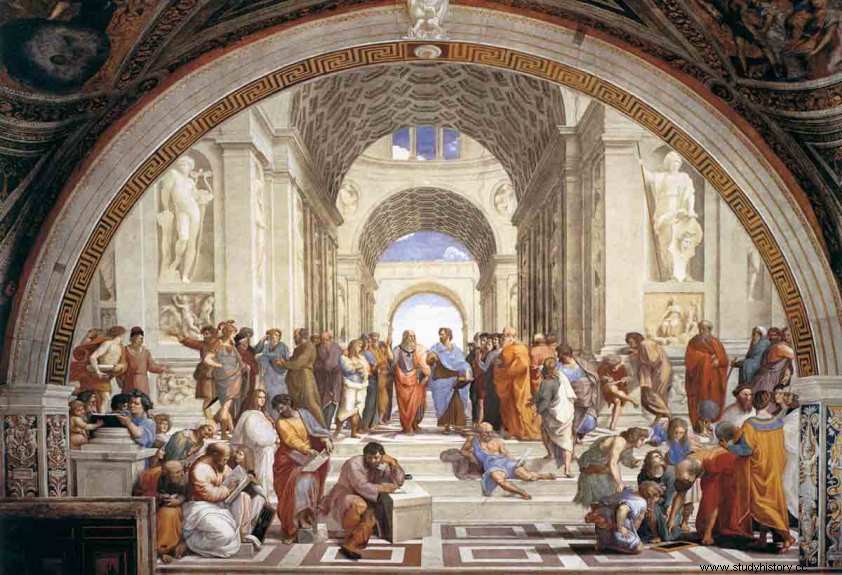
Located in a dense wooded area north-west of Athens, near the suburban suburb (suburban area of the Greek capital) of the city, the area dedicated to the Academy it is accessible through the dromos , the main street of Athens in terms of size and length, capable of crossing the entire capital, touching the most characteristic places of the Acropolis and Agora, and then ending around the Necropolis of Ceramics. To characterize this road are not only its considerable size, but also the importance that was attributed to it by the Pisistratids in the context of the Panathenae , a polyadic feast dedicated to the goddess Athena as protector of the city, who placed their own pompé (procession) right along this road, and came to an end approximately in the Accademia area, near the village of Colono. To distinguish the beauty of this verdant place, there is also the Cefiso river, which bathes the Athenian plain together with the Illyssus and rises between Mount Parnete and the Pentelico, to the west of the city.
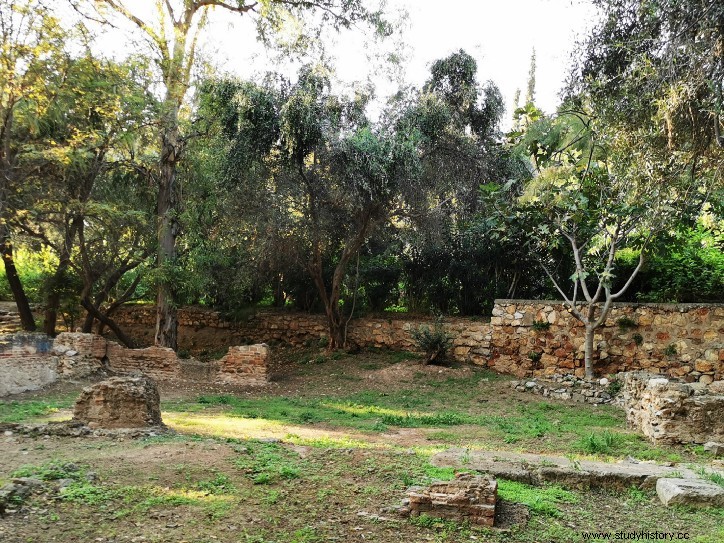
It is a strongly ideological place, full of symbolic, educational and cultural meanings, as well as being the holder of the primary role as the main seat of the Athenian gymnasium. Its main function would in fact consist precisely in guaranteeing perfect athletic training, to prepare Athenian males for war from the age of 11-12, and educational, based on the teaching of letters, music and poetry, the foundations of the culture of Athens. . The main purpose of the Academy was, in reductive terms, to prepare for the ideal daily life of the Greek capital those who would one day be the citizens of the future, that is, the young Greeks, both physically and morally / intellectually. We know with certainty that this role was played very well and many of the leading intellectuals, philosophers, athletes, politicians and even artists of the city were "forged" in the Academy itself, which also came into contact over the centuries with characters all 'other than marginal, from Plato to Justinian I .
History and foundation
Despite the fair knowledge that we currently possess about this area, all the knowledge that goes back to its foundation is much more ephemeral, and its history is therefore still quite uncertain. Therefore, like any place rich in tradition, antiquity and symbolism, numerous myths and legends inevitably derive from everything concerning the Academy about its history and its foundation of origins.
In fact, the term "Academy" itself derives from a deep-rooted lexicographic tradition, capable of symbolically projecting the origin of the gymnasium into the myth, identifying its greatest founder and protector in the figure of the Athenian hero Akademos (or Ekademos ), today identified as the eponymous hero of the place itself. It was he who gave the original name by which this area was indicated, namely the " Akademia “.
The theories on the role played by this character, however, appear uncertain and multiple, starting from the hypothesis that it was closely related to the saga of the kidnapping of Elena by Theseus, and to the arrival of the Tindarids in Attica in search of their missing sister. In a further version of the legend, this character would even have been the arcade king of Tegea, and would have led the Dioscuri in the conquest of the Attica region. Finally, as a last alternative considered, Akademos he could have simply been a normal inhabitant of the Academy, who would have however indicated to the Tindarids the place where his sister Elena had been carefully hidden, thus earning the eternal gratitude from the Spartans and the guarantee of always receiving significant favorable treatment from their part.
The first suppositions about the origins of this mysterious place date back to around the eighth century BC, when a prehistoric building was accidentally found in this area, which was probably mistakenly identified as the "House of Akademos “, And then transformed into a place of worship. Despite this hypothesis was shelved almost immediately, we know for sure that the Academy's link with the hero and the history of its foundation represent very ancient elements. There are three more recent theories, and place the Academy's origin around the sixth century BC. The first relates to a horos , medium-sized stones placed as boundaries of sacred places or places of great importance for the city, found in situ, capable of attesting to an at least late antique origin relating to the toponym connected to the name of the hero. A less accredited hypothesis would be based instead on the recognition of the figure of Akademos found on a black-figure vase (pictorial practice for Greek and Roman ceramics of the end of the 6th century BC). Finally, the first real mention of the existence of a gymnasium in the Academy can be traced back to a very strict exemplary law that Demosthenes attributed to Solon, who was archon around 594 BC . This law condemned anyone who had committed a theft of personal items near the Lyceum, the Academy and / or the Cirosangue to the death penalty. Thanks to this passage we can therefore chronologically attribute the existence of three Athenian gymnasiums. However, even this last hypothesis would present a margin of uncertainty, since it was common practice, starting from the fourth century BC, to attribute any kind of legislation established to Solon, who was "labeled" in the Classical age as an archetypal model of ideal legislator and father of the homeland.
However, its history and its very long cultural tradition have distinguished it as one of the richest places in mnemotopoi of all Athens; if not all of Attica. This Greek expression, fundamental for the study of ancient sites, is formed by the terms “ mnemo "And" topos ", Which respectively indicate the memory and the meaning of a place / area. It is in fact a place full of symbolism and traditions, elements that inevitably refer to the past and consequently to a long history full of memory. The mnemotopes they embody the mythical, the magical and also the religious at a historical level, characterizing works, battles and events that are particularly significant for posthumous remembrance and celebration; but also legends, superstitions and remnants of memory worthy of being remembered for the history of a given area and for its traditions rooted over the centuries. Just as it happens for the Academy, it is therefore an environment full of cults and commemorations.
Currently, despite the wealth of sources, traditions and legends concerning this area are numerous, almost nothing has come down to us at an archaeological level and therefore it is also very complex to carry out an effective reconstruction of how the Academy could have really been at an architectural level. However in Athens, on the banks of the Cefiso river, it is possible to admire in a small site, near an area rich in vegetation, the remains of a building attributable either to the part relating to the gymnasium or to the Academy proper.
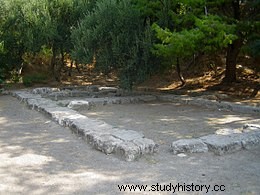
The symbolic importance of the Academy
Although the Academy of Athens lends itself perfectly as a symbolic place full of pathos , myths and legends, we know with certainty that it really played a role that was anything but marginal in the history of the Greek capital; and not just for a few years, but for entire centuries, until the emperor Justinian I, in 529 AD , ordered the closure of all philosophical schools in the Byzantine Empire, as they are pagan and Christianity has recently become the official religion of the state.
However, to testify to us the great importance of the Academy we find not only the illustrious personalities who over the years and centuries had to do with the aforementioned area, but the latter is also documented through simple elements that we could define "material", capable nevertheless to play a role of fundamental importance. We are talking about the aforementioned horos of the Academy. Although they are only small stones of variable size with rectangular shapes, the horoi they showed themselves as real symbols of delimitation. Their task consisted precisely in demarcating the boundaries of a place, and they were never just any environments, but rather areas worthy of a well-defined delimitation such as temples, sacred areas, ritual areas and buildings full of political, symbolic or intellectual significance. And the fact that the Academy had its own horos personal only adds to its prestige. This "stone", found in a fairly recent excavation, is even placed on a base, given its considerable size, and not directly in the earth as it was customary to place them. The stone is rough, with the exception of a smooth strip on which the phrase was engraved:" I am the horos of the Academy ". It was in fact common to "give the word" to these stems to communicate the boundaries of places as directly as possible to passers-by. This use is not surprising, as tombs, statues and epigraphs are also “endowed with words” near paths and cemeteries.
But it was no coincidence that this very area was so carefully circumscribed. Its dimensions were in fact considerable and the functions that it covered within Athenian politics and society were just as significant. Therefore, if we wanted to describe this place with a more current expression, one of these would certainly be "school". The Academy was in fact a school building in all respects and, using rather generic terms, its role was precisely to form the physical, educational and above all intellectual aspect of young Athenian citizens, mostly males . However, the gender issue should not be taken for granted, as it is not sufficiently documented that women could not also date. .
As far as physical preparation is concerned, the Greeks (especially the Athenians) had a real cult of the body, both on the aesthetic side and on that of prowess; The numerous statues depicting a perfect sculptural nudity which were aspired to are not only in the artistic field, but also in that of everyday life, testify to this. In fact, the Academy had a Gymnasium, which is a specific place carefully designed for the physical and athletic training of young people who began training around the age of 11-12. The training was mainly aimed at the war preparation of the boys but, as previously reported, the importance that was given to the aesthetics of the body cannot be excluded. The athletes competed naked, and most of the time they even trained like that. The term “gymnasium” derives from the Greek “ gumnos “, Which really means“ naked ”. It is a very characteristic place for Athenian culture, important for meeting and learning, in addition to the fact that banquets and theatrical performances could also be held in it. At the age of 18, young people reached ideal physical maturity and thus acquired full citizenship rights, undertaking real military education as ephebes .
Although physicality was essential for the "construction" of Athenian culture, an equally significant role was played by education. The main purpose of the Academy was precisely that of educating and "molding" young people to culture, so that they could reach their maximum physical and intellectual capacity in parallel. Athenian education was mainly based on learning letters (writing), accounts (mathematics) and poetry, which was very often accompanied by the music of the zither or lyre, instruments always learned within the Academy. The young people practiced on wooden or wax tablets and were always supervised by very careful and also very strict teachers. Although culture was still a rather elitist privilege, attending "school" was more common than one might think.

The Academy therefore represents a cultural reference point for the aggregation of citizens (young and old) and for the complete training of Athenian children. Being a citizen of the Greek capital represented in fact a real pride, a way to express one's pride and to distinguish oneself from all those who, coming from the most disparate areas of all Greece and much beyond, were considered barbarians and therefore enemies. / P>
The role of Plato
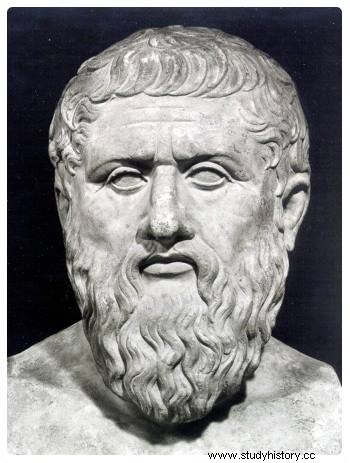
Most of the time when we talk about the Academy it is, almost always incorrectly, exclusively associated with the figure of the philosopher Plato , which played an extremely important role in its practical and historical evolution, but not exclusive. It is therefore common practice to associate this area with the presence of the philosopher as its one and only founder due to the fundamental role he played in the following centuries, thus tending to unconsciously obscure previous and subsequent centuries of history.
Plato made his first appearance in this place only in 387 BC . This particularly symbolic date, as well as being the one best known compared to the Academy, represents the moment of the first foundation of the academic school, especially as we know it today. In fact, Plato embodies the figure of the "schoolchild" par excellence, that is the one who was at the head of a philosophical school or the founder himself. All his disciples were also indicated by this term. 20 years after this representative date, Plato will also buy, on his return from a long trip to Sicily, a garden ( képos in Greek) called the "garden of Akademos", which later became the real main seat of the school. It is an almost bucolic and idyllic place that will last for centuries, until the Roman conquest of the Greek world. It will be in this area, enormously appreciated by the Romans for its history and its mythical and naturalistic characteristics, that the Latins will go to listen to the great Greek philosophers. In this sense, Athens will become the capital of culture and art, transmitting for generations an immense fascination not only for the Greeks, but also for many other peoples to come.
With the arrival of Plato in this area, not only does the symbolic meaning of the Academy expand, but also all the teaching subjects, which increase considerably, becoming more and more specific and detailed. We know almost with certainty that subjects such as mathematics, astronomy, optics, mechanics, natural science, political science and, of course, philosophy were taught in the Platonic age. In fact, it was common practice to discuss with the teacher all those issues strictly related to man and everything related to the human question, in-depth investigation also through art; in fact, the paintings depicting the typical scene usually depicting Plato walking in this green area surrounded by his attentive disciples are common.
To suffer from the Platonic influence in the Academy were not only the Athenian citizens, assiduous frequenters of this place, but also and with good probability above all the Romans, who following the conquest of the Attica region were "infected" by countless elements of Greek culture, adopting or even exporting them. And it wasn't just ordinary Roman citizens. Cicero in 79 BC he will attend the Academy with great involvement, followed by his brother Quinto and from the great friend Attic , named in honor of his immense love for the Attica region and in particular for his great cultural background, which developed in this area.
However, the success of this place will continue for centuries and centuries after Plato's death, thanks to the fortune it earned by leaving an immense legacy thanks to Platonic philosophy, studied and appreciated by peoples and cultures even very distant from the Greek one. Only at the beginning of the fifth century was a new school founded as a cornerstone of Neo-Platonic philosophy, and the Academy would then definitively cease its activity only in 529 AD , at the behest of Emperor Justinian I who, due to the importance that Christianity was acquiring as a religion of the Empire, had ordered the closure of all pagan philosophical schools present in the Byzantine Empire. Despite this, the Academy remains a place full of symbolic and cultural meanings, a nucleus full of mnemotopoi , representing throughout the ancient age the symbol of Platonic philosophy and of the Athenian capital, a cultural and educational backbone for ancient Greece as we know it today. Therefore there are countless authors who still argue about its importance and have had to deal with its multiple symbolic meanings; from the Pisistratidae family (tyrants of Athens) who, especially his son Hipparchus, a lover of art and culture, always paid particular attention to this place, preferring it as a meeting point and cultural exchange, to Plutarch , who still in the imperial age defined himself and other thinkers like him with the proud name of "academics" (" akademikoi ").
Many other famous people over the centuries took an interest in this place not only historically but also artistically, such as Raphael , who painted "The School of Athens" located in the Stanza della Segnatura (one of the 4 Vatican Rooms located inside the Apostolic Palaces), a work of majestic dimensions depicting the protagonist Plato in the center, surrounded by his disciples evidently kidnapped by his philosophical speeches. The work fully embodies the vision that was given to the Academy area as the main symbol of Platonic philosophy, while it is less evident how it was identified before Plato's arrival, despite its origins being much older.
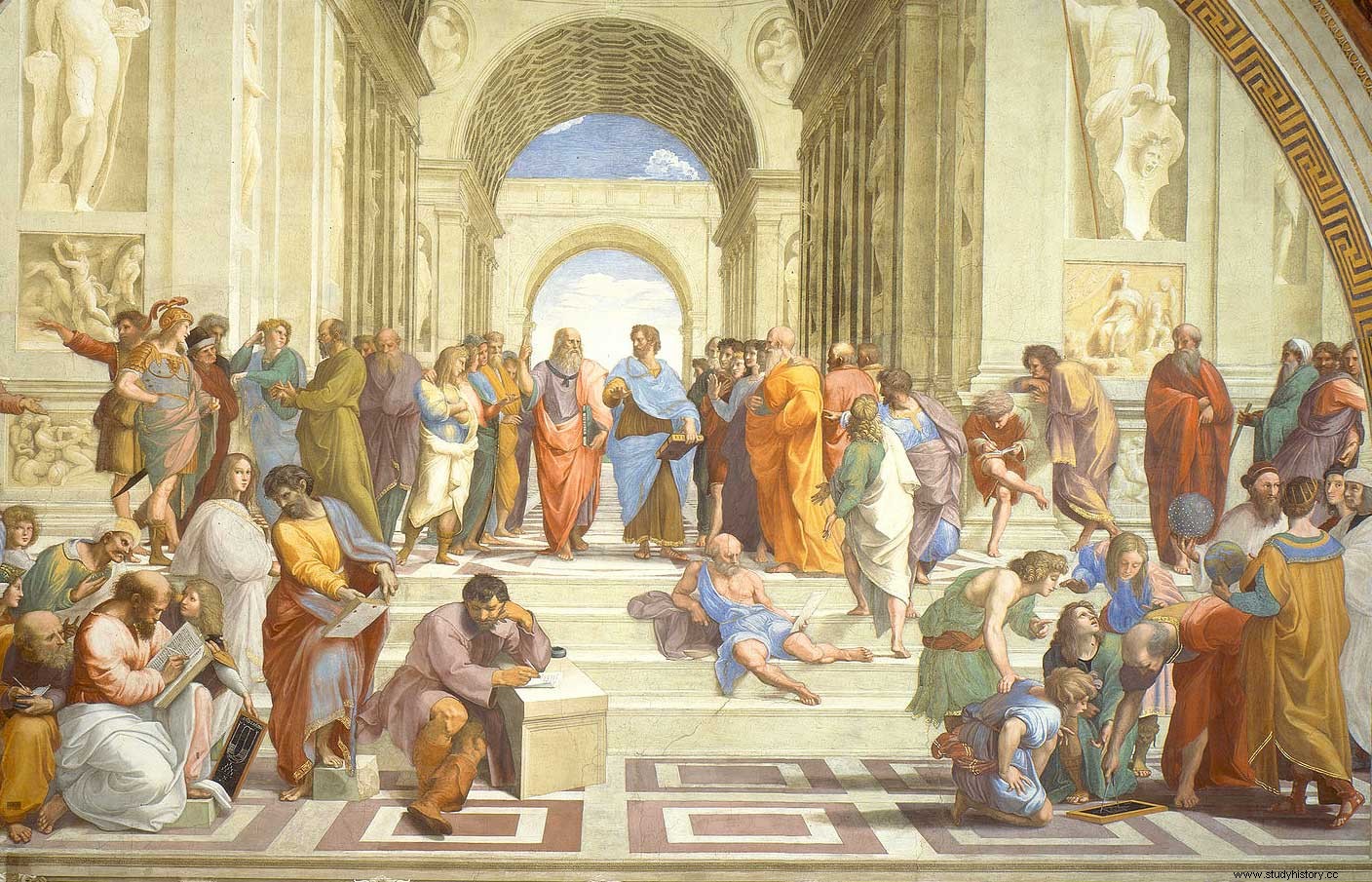
Obviously, although the eras, the protagonists and the role played by this area have changed, what never changes is the pride and the strong admiration with which those who have come into contact speak and describe it; instead using a mixture of magic and veneration all those who discuss it for reasons of study, interest or hearsay.
